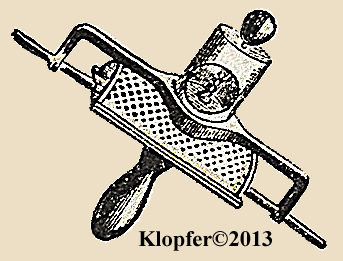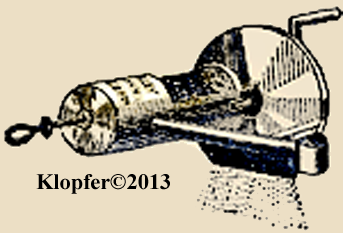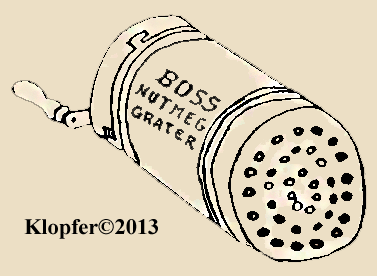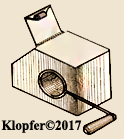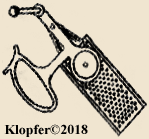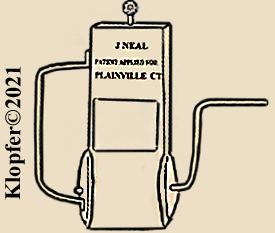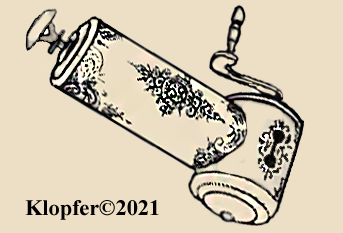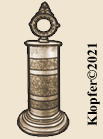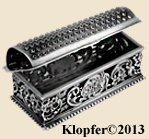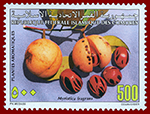
Click Me!
NutmegGraters.Com

- Home
- Featured Stories
- Picture Gallery
- Info.Wanted :
- Spurious Marks
- Trading Post
- Contact Our Site
- Wanted To Buy
[WELCOME: My articles published on NutmegGraters.Com and commercially (elsewhere) required many years of primary research, personal expense, travel and much effort to publish. This is provided for your enjoyment, it is required that if quoting my copyrighted text material, directly provide professionally appropriate references to me. Images are unavailable for copy. Thank you J. Klopfer.]
_______________________________________________________________________________________________________________________________________________________
The "Ever Ready Nutmeg Grater" by the H. G. Saal Company
With Its Deceptive "MT&E Co." Logograph!
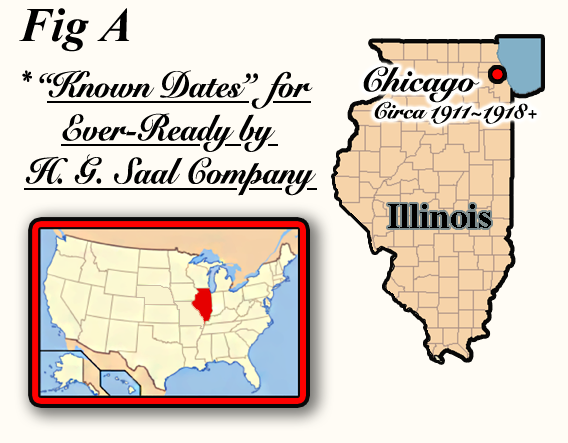 The Ever Ready Nutmeg Grater was the product of the H. G. Saal Co, Chicago, Illinois, USA (Fig A). It bares the fictitious "MT&E Co." logograph (Fig B) embossed on front, derived from Saal's local advertisements of the time, with the corresponding initials representing "Models, Tools & Experimentals". Saal's main business served as jobbers and as limited manufacturers for the creation of various small dies and tools. A genuine firm named "MT&E Co." never actually existed. Throughout his life, Saal applied numerous spurious product and business names among his various financial enterprises and on some manufactured goods. The reasoning behind this practice is unknown, but it seems that Henry G. Saal used this technique to give an appearance that he was very successful, owning many different businesses, which to some degree became true.
The Ever Ready Nutmeg Grater was the product of the H. G. Saal Co, Chicago, Illinois, USA (Fig A). It bares the fictitious "MT&E Co." logograph (Fig B) embossed on front, derived from Saal's local advertisements of the time, with the corresponding initials representing "Models, Tools & Experimentals". Saal's main business served as jobbers and as limited manufacturers for the creation of various small dies and tools. A genuine firm named "MT&E Co." never actually existed. Throughout his life, Saal applied numerous spurious product and business names among his various financial enterprises and on some manufactured goods. The reasoning behind this practice is unknown, but it seems that Henry G. Saal used this technique to give an appearance that he was very successful, owning many different businesses, which to some degree became true. 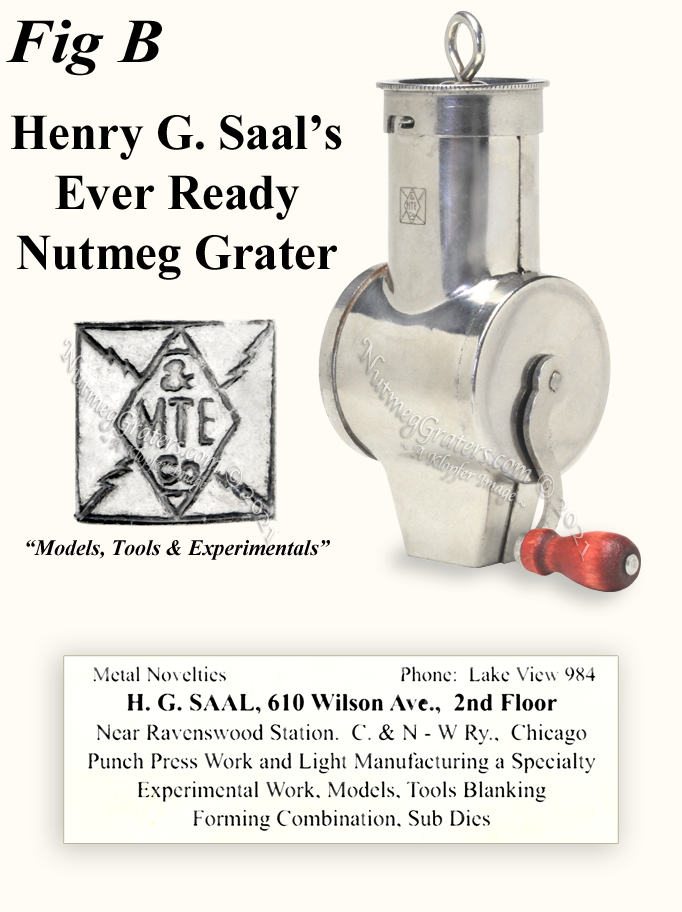
At age 21, Henry George Saal (1874~1933) (Pictured Below Right: At age 48) had moved with his parents and sister, from Ohio to Chicago in 1896. When George Saal (Henry's father) died in 1898/9, Henry, then only 24 years old, became bread-winner for himself, his sister Alice and mother Louisa. Henry's earliest employment varied annually being a salesman, an electrician and then a machinist. In 1903, Henry opened business as a "Die Maker" at 610 Wilson Avenue, in the northern part of Chicago. Sanborn's Fire Insurance Map of 1905 (MAP SNIPPET: Fig C) labels the firm"H. G. SAAL, LIGHT MFG & EXPERIMENTAL W'K" (INSERT: Fig C1),  showing a small second story walk-up business (23 feet frontage by 32 feet deep) over a large "DANCE & LODGE HALLS" complex. The business started at this location with only $71.00 cash and an additional loan of $800.00 A paid advertisement in the 1904 Chicago City Directory described "Metal Novelties", "Punch Press Work and Light Manufacturing a Specialty, Experimental Work, Models, Tools, Blanking, Forming Combinations, Sub Dies" located "Near Ravenswood Station ~ C. & N-W Ry." The business quickly flourished with H. G. Saal Company demonstrating the highest quality precision in design and in workmanship, to include the wide range in metal specialties of enameling, plating, burnishing, and polishing.
showing a small second story walk-up business (23 feet frontage by 32 feet deep) over a large "DANCE & LODGE HALLS" complex. The business started at this location with only $71.00 cash and an additional loan of $800.00 A paid advertisement in the 1904 Chicago City Directory described "Metal Novelties", "Punch Press Work and Light Manufacturing a Specialty, Experimental Work, Models, Tools, Blanking, Forming Combinations, Sub Dies" located "Near Ravenswood Station ~ C. & N-W Ry." The business quickly flourished with H. G. Saal Company demonstrating the highest quality precision in design and in workmanship, to include the wide range in metal specialties of enameling, plating, burnishing, and polishing.
Business was booming. Shown as a vacant lot in Sanborn's Map of 1905 (Fig C2), Henry Saal selected this site to build his new factory at 1183 W. Ravenswood Park, only two blocks south of his Wilson Avenue location. In operation by 1907, the factory was built in the popular Prairie style (Fig D). In 1910, the H. G. Saal Co's factory was re-numbered as "4410" W. Ravenswood Park [this street number still remains today]. It was designed as a model manufacturing plant for inventive metal design work. Saal's new factory boasted an aggregate floor space of 27,000 square feet, arranged into various departments to accommodate experimental work and model production of all imaginable types.
 The lot size covered an area of 100 by 112 feet and was occupied by the factory and its warehouses. During this period, the American economy was flourishing. Experiencing great success, Henry expanded his business into adjacent lots when they became available for sale, purchasing an adjoining vacant property of 200 X 100 feet to build a two story addition. In 1913, one documented instance occurred when Henry purchased John Fishleigh's nearby business at 1193 W. Ravenswood Park for $5000.00. By 1917, the plant was in full operation, day and night, employing 350 skilled mechanics.
The lot size covered an area of 100 by 112 feet and was occupied by the factory and its warehouses. During this period, the American economy was flourishing. Experiencing great success, Henry expanded his business into adjacent lots when they became available for sale, purchasing an adjoining vacant property of 200 X 100 feet to build a two story addition. In 1913, one documented instance occurred when Henry purchased John Fishleigh's nearby business at 1193 W. Ravenswood Park for $5000.00. By 1917, the plant was in full operation, day and night, employing 350 skilled mechanics. 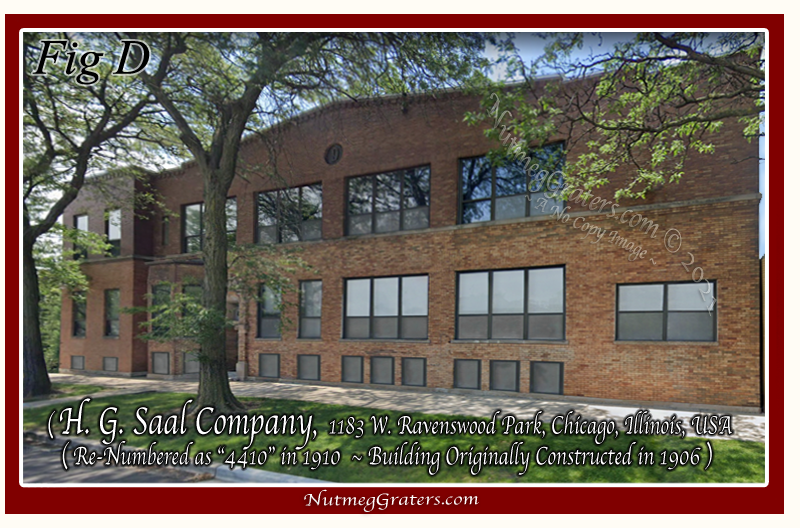

H. G. Saal Co. Expands Product-Line Into Kitchen Hardware Specialties:
H. G. Saal Company initially designed dies, gauges, jigs, models and tools, but by 1910, they began producing a wide variety of kitchenware items. In addition to their Ever Ready Nutmeg Grater, the company produced the Peerless Can and Bottle Opener, the Jumbo, the Peerless Cherry Pitter, the Clean Cut and numerous other kitchen hardware specialties. Their best seller... the company "turned out" thousands of can and bottle openers each day.
The specific date when the Ever Ready Nutmeg Grater was entered into production remains unclear, but based on advertising as seen within the Norvell-Shapleigh Hardware Co. Wholesale Catalog (Fig E1), their marketing originated in 1910 or 1911. The reader will notice two errors contained in the Norvell-Shapleigh ad: Firstly, the ad incorrectly names it the "Peerless Nutmeg", while inaccurately illustrating the embossed name "PEERLESS" descending down its front; Secondly, this nutmeg grater is incorrectly described as "Nickel Plated Brass". There are no known examples within public or private collections baring the imprinted name "PEERLESS", nor are any of these nutmeg graters known in "Nickel Plated Brass". A simple magnet test reveals all Ever Ready Nutmeg Graters as "extra heavy sheet metal, nickel plated". [This simple test: a magnet will attach to the sheet metal under the nickel plating, while nickel plating over brass is not magnetic.]
In 1911, Henry G. Saal cleverly submitted his Ever Ready Nutmeg Grater to the Good Housekeeping Magazine's product laboratory, where it earned their "Seal of Approval" (Fig E2). Although the magazine description did not include an image, this publication was in high volume circulation among homemakers everywhere. Being an endorsed product undoubtedly resulted in significant increased sales of the Ever Ready Nutmeg Grater.
So, how did the mistaken "Peerless Nutmeg Grater" name originate? On the national level Peerless was a very popular name appearing on a large number of products, and served as many company names. In 1910, the Peerless Specialty Co. of Chicago, first opened at 40 River Street with John D Houck as manager and in 1912, Houck identifies his "Peerless Specialty Co." advertised within an internationally known housewares trade publication, as the wholesaler "in a position to supply all demands for their Ever Ready Nutmeg Grater" (Fig E3). Within this ad, notice that the "EXTERIOR" image (on the left) bares what appears as blurred lettering on the lower spout giving the false impression that the Ever Ready Nutmeg Grater was protected by a "PATENT"; however, it was never patented. Observing Chicago City Directories [addresses listed below], the Peerless Specialty Co. existed for only three years, later becoming Hardware Specialty Co. in 1913 and 1914 with Houck as "president", now located with H. G. Saal Co. at their 4410 W. Ravenswood Park Avenue address. By 1915, neither "Peerless" nor "Hardware Specialty" Co's continued, and afterwards, John D. Houck became situated elsewhere in other various areas of business management enterprises. The United States had entered World War I in 1914 and the demand for the houseware's market declines.

During World War I, Hibbard, Spencer, Bartlett & Co. of Chicago were the largest home furnishing goods wholesalers in Chicago and in 1915, they marketed the Ever Ready Nutmeg Grater for H. G. Saal Company (Fig E4). Their ad correctly described the Ever Ready as constructed in "extra heavy sheet metal, nickel plated". It was sold to merchants "one dozen in a package".
An exhaustive investigation of house furnishing trade catalogs and kitchenware buyer's guides that market housewares to national and international retailers, show the Ever Ready Nutmeg Grater was listed only from 1911 to 1918, after-which it no longer is found. Also, NutmegGraters.Com has yet to document any advertisements for the nutmeg grater appearing after 1917. Although possible that the Ever Ready Nutmeg Grater remained available as a lesser and non-advertised product, it seems more likely that the nutmeg grater was discontinued by 1919 and H. G. Saal Co. moved toward production of more timely and lucrative commodities. In 1919, H. G. Saal Co. relocated their main address to 1800 Montrose Avenue, Chicago, Illinois, USA. They continued manufacturing in multiple locations throughout Chicago.
H. G. Saal Co. Develops More Profitable Product Lines:
H. G. Saal Co. diversified their products developing a surprising array of goods. Between 1916 to 1935, Henry Saal received dozens of patents for his new inventions. Today, Saal is celebrated as a pioneer in the radio field. Saal's most profitable venture was in the manufacturing of his "talking machine motors" (commencing about 1916), a product line that was continually on the cutting edge of new technology. In addition to manufacturing goods, Henry Saal became active in bank administration and in real estate development. Following is a time line overview of Henry's growing business ventures:
About 1916 "Manufacturers of Talking Machine Motors", with Saal becoming the president of the Perkins Phonograph Company of Chicago.
1920-1927+
Expanded products into "Stationers, Engravers Blank Books & Loose Leaf Specialists".
1920 Banking : Director of Capital State Savings Bank.
1921-1926 Director Sheridan Trust and Savings Bank.
1922 Entered into a 2 million dollar property development venture (containing a department store, theater for 5000, an amusement company, & hotels).
1922
Developed automotive products: The Saal Oil Shooter for chassis lubrication of contact cups for Ford and other automobiles.
1923 "The H. G. Saal Company now operate five factories in the city" and planned building a major new factory "for the production of phonograph
motors, radio equipment and auto accessories".
1923 Builds a new 254,000 square foot three story factory on Ravenswood (bordered by Argyle, Ainslie, Lincoln Streets and the North-Western
Railroad).
1924 H. G. Saal Company, Baldwin Radio Sales Corporation, and Perkins Phonograph Co. are all listed at 1800 Montrose Ave., Chicago with Henry G.
Saal as the president of each company.
1925 Produces both the Soft Speaker and the Symphony Grand Radio.
1926 Reported in The Talking Machine World, "H. G. Saal Co. organized a recreation club, purchasing twenty acres and a clubhouse at Pistakee Bay, Ill.,
where the employees could spend the week-end holidays" spending their leisure time due to the new "5 day work week".
1926 Produces both the Pedestal Speaker and Ec-centric Cone (14 & 20 inch models).
1929-1933 The Great Depression occurs
with Saal's many patents curtailed in 1926. [NOTE: Henry filled one final patent in 1932 for an "Automatically
Changing Phonograph Records", embroiled in a lengthy court battle for its ownership, patent granted in 1935 ~ two years after Saal's death.]
Henry G. Saal's Private Life And His Transgressions Publicized:
Little is actually known regarding Henry Saal's private life, yet becoming a wealthy millionaire draws significant public attention. At age 37, Henry G. Saal married Caroline Buelow (1889-1972) in La Porte County, Indiana on May 21, 1912, when Caroline was only 23. The couple's first and only child was their son, Meta C, born in 1917, but sadly, the boy died that same year before his first birthday. Although divorce became more socially accepted in the 1910's & 20's as "a new morality" swept through the American culture, it was still a rare occurrence (.1% percent or 1/1000), and it was in 1919 when Henry's first marriage to Caroline ended in divorce. [NOTE: In 1924, at least one newspaper incorrectly reported that Caroline earlier had "died" leaving Henry a widower, but this was not an accurate account.]
It was with Henry's second marriage that a public scandal would soon break across the newspapers...
Rumored in press coverage in 1923, it was stated that soon after Henry's first divorce, he had remarried (about 1919 or 1920) to the young "artist's model" and "former stage model", Violet Fiel Saal. It was reported that she had pursued him into marriage "after she asked him about a dozen times" and that Violet later publicly implied that her relationship with Henry actually originated while he was still married with his first wife.
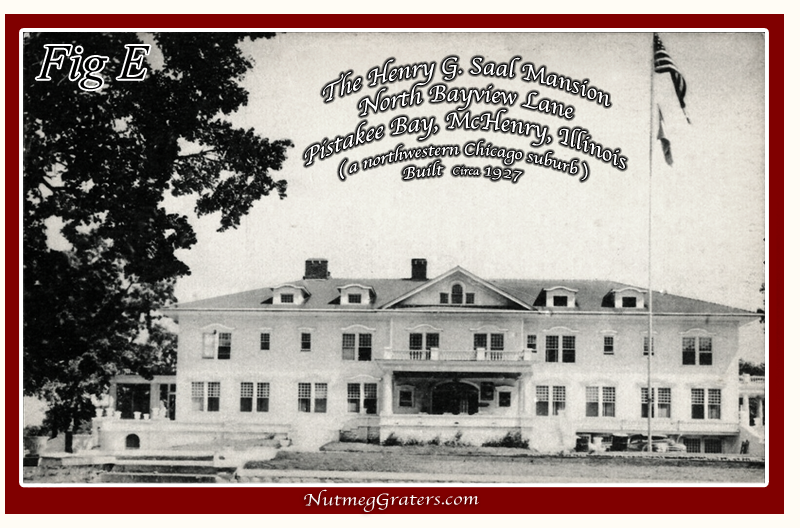
Violet Fiel Saal filed for divorce on August 30, 1923, after only about 4 years of marriage. Salaciously reported, Violet "caused a 'Gold Coast' furore by declaring her millionaire husband wore women's silk stockings" while also charging him "with cruelty and drunkenness!" [NOTE: The 'Gold Coast' remains the wealthy and sophisticated area for high society in center city Chicago.] During 1923 and into 1924, newspaper headlines widely carried the Saal divorce story from Ohio to Missouri, on to New York, Nebraska, Mississippi and elsewhere. One newspaper account reported on July 22, 1924 that "Violet Fiel Saal, age 23, was to testify today." [NOTE: It scandalously made Violet appear to be only aged 19 when she married the 45 year old Henry. However, according to NutmegGrater.Com's research, Violet was born in 1898, making her about 22 when they married and at age 26 during the court hearing. Much posturing occurred during their divorce proceedings.] Charges and counter charges were bitter, and opposing attorneys engaged in physical altercations, having physical brawls across the duration of court testimony until the Judge threatened "another fight in this court, and participants will go to jail." It was reported that after "the usual day's thrill... quiet reigned thereafter." A divorce was finalized.
And then, there is the occurrence of Henry's mansion, built after "The Kingsley House" burned on Pistakee Bay, McHenry, Illinois...
Built in 1892, "The Kingsley House" (later named "Mineral Springs", followed by "The Pistakee Bay Hotel") beautifully faced the large bay: complete with a bowling alley, boat rentals, the beach, a wharf and other amusements. Clams were prevalent to this area, and clambakes became a common, and celebrated festivity at the hotel. Ownership and name changes occurred. In 1915, the facilities's doors closed to business after being purchase by a John Early, who became permanently ill causing the hotel to fall into non-use. Henry G. Saal purchased the 20 acre facility in 1926, claiming his plans "to develop the hotel into a private resort for his company employees and staff". However, his vision was short lived, in that the hotel was completely destroyed by fire. Instead of rebuilding the site, Henry Saal constructed an impressive mansion for himself, Circa 1927 (Fig E). Located on North Bayview Lane, Henry's stately home was one of several impressive mansions constructed in this area, just before the Great Depression of 1929.
At the age of 59, Henry George Saal died December 20, 1933 in his "palatial home on Pistakee Bay" in McHenry, Illinois. The newspapers described him as "retired", but nothing is found as to how he passed away. On December 23, 1933, Saal was buried near his childhood home in Wooster, Ohio. In the years that followed his passing, there were several lawsuits. Henry's mother and sister jointly filed suits claiming ownership to Henry's radio and phonograph patents. In effort to collect bond debts, banks sued against the mansion, although prior to his death, Henry had transferred its ownership within a trust, making it non-available as an asset after his death. Later, the mansion transitioned: becoming a school, a nursing home, the "Italian Welfare Council" summer camp, and today, the retreat house "Villa Desiderata". Henry's remaining businesses continued independently after his passing.
The Ever Ready Nutmeg Grater was very successful, with many being sold. Easy to find, it is an inexpensive purchase for modern collectors buying within today's antique market places.
[KLOPFER article © May 2021]
